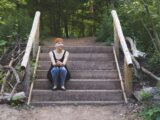UPDATE: This story was updated on Feb. 23 to add an additional statement from The United Church of Canada.
Researchers and land surveyors announced that they have identified 67 children who died while at Alberni Indian Residential School and found 17 physical features that could indicate unmarked graves. Tseshaht First Nation released the findings earlier Tuesday at the site of the former United Church-run institution.
The United Church managed about 15 residential schools, but this is the first to announce results of an investigation into unmarked graves.
Only about 12 hectares of the 100-hectare area surrounding the site near Port Alberni, B.C., on Vancouver Island have been scanned so far. It is possible that, even with ongoing research, the number of children who died at the school will never be known, said elected chief councillor Wahmeesh, whose English name is Ken Watts.
“We will never know the exact number of children who did not make it home. However, we are committed as a nation to uncover the truth of what happened,” said Wahmeesh during a ceremony rooted in traditional Indigenous culture and attended by survivors, their families and community members.
“We need to remind the world that these were just children . . . . There should never be cemeteries at schools,” Wahmeesh said.
Alberni Indian Residential School opened in 1900 and was initially managed by the Presbyterian Church. From 1925 to 1969, the school was operated by The United Church of Canada and was attended by children from about 100 communities throughout the province. It was taken over by the federal government in 1969 and closed in 1973 after pressure from First Nations chiefs.
The United Church of Canada said in a statement Tuesday that it “acknowledges and is saddened by what we have heard.”
In a further statement on Wednesday, the denomination said that it was an “active and willing participant in the operation of residential institutions. We were wrong to participate in this colonial, racist, and oppressive system.”
“With deep remorse and grief, The United Church of Canada acknowledges the truth at the Alberni residential institution, which was run by the United Church. This is not new information for Indigenous communities; Indigenous people have been telling the world about deaths and unmarked gravesites for a very long time. We have not always listened to or heard you.”
The statement said that United Church actions have contributed to trauma, death and the loss of culture and language, and that the denomination is working to “reconcile our legacy as perpetrators in this system.”
The potential graves were found through a combination of ground-penetrating radar and other observation methods, including information from survivors, said Brian Whiting of GeoScan, a B.C.-based land surveying company.
The evidence of graves is indirect, meaning there are geophysical anomalies that could indicate graves. “We don’t see human remains,” Whiting said in his explanation of the technology’s capacity.
The research section of the project was led by Sheri Meding, who worked with survivors to identify children who died at the school and the likely cause of their deaths.
“The survivors told us where to look and they were correct,” she said.
Since the official record at the National Centre for Truth and Reconciliation memorial registry says there were 29 deaths at Alberni, the additional names will be added to the registry.
Many records are missing or difficult to access, but the United Church has made all its records available, Meding said.
“So, we are grateful for that. We could never have come to the research results we had without the records that were made available,” she said.
Overwhelmingly, medical conditions accounted for most of the deaths, Meding added, as conditions at the school were inadequate and unhealthy.
“There were many deaths in the pre-1920s, but the poor conditions at the school continued on until the 1940s and 1950s,” she said.
Tseshaht First Nation is making numerous recommendations to the federal government and the United Church, including making funding available to continue the research and to demolish remaining residential school buildings.
“This is just the first phase,” Wahmeesh said.
“Let’s ensure that we commit to educating future generations so this never happens again. So they have respect for what happened to our children and (know) why we can’t just get over it, because it takes more than one generation to get over 150 years of colonization and abuse of our people,” he said.
CORRECTION: A previous version of this story stated that the area around the residential school site is 1,000 hectares. It is actually 100 hectares. This version has been corrected.
If you are a residential school survivor or have been affected by the residential school system, you can call the 24-hour Indian Residential Schools Crisis Line at 1-866-925-4419.















